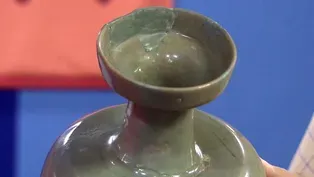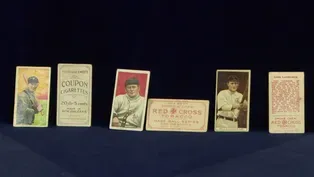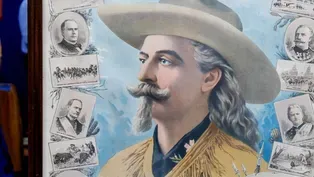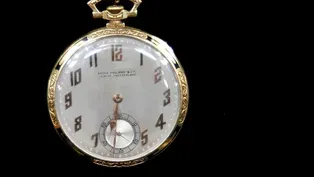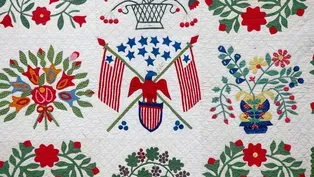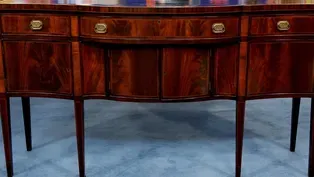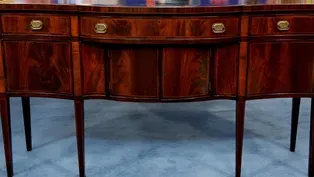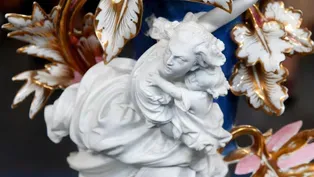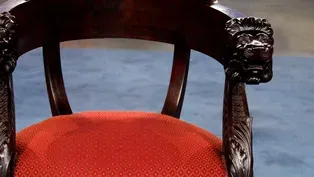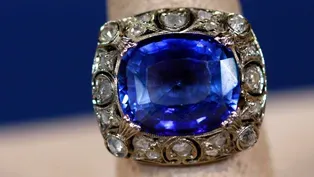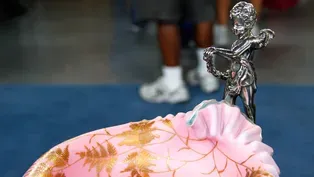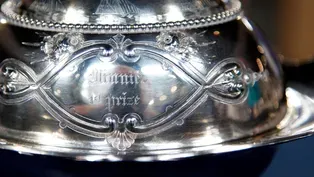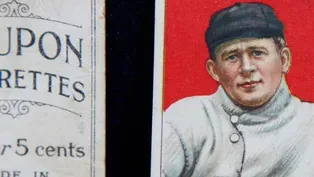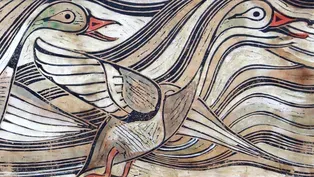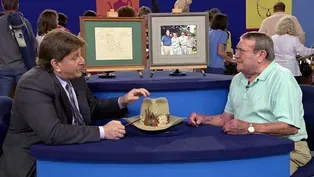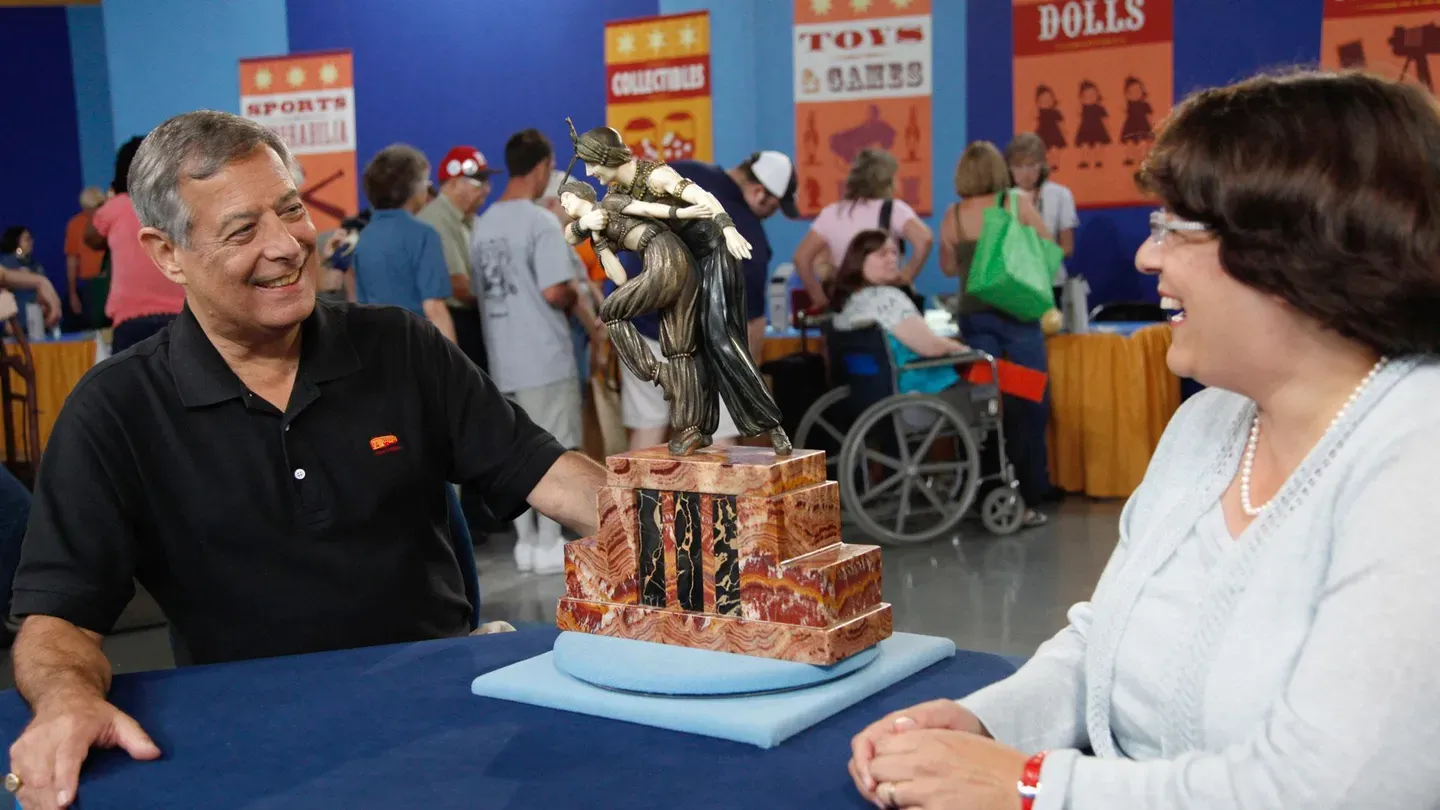

Biloxi, Hour 1
Season 15 Episode 13 | 52m 59sVideo has Closed Captions
ROADSHOW examines the eccentric pottery of George Ohr at the Ohr-O'Keefe Museum of Art.
In Biloxi, Mississippi, host Mark L. Walberg joins appraiser David Rago for a look at the eccentric pottery of George Ohr, overlooked in his lifetime during the mid-19th and early 20th centuries, but now the celebrated centerpiece of Biloxi's Ohr-O'Keefe Museum of Art.
Problems with Closed Captions? Closed Captioning Feedback
Problems with Closed Captions? Closed Captioning Feedback
Funding for ANTIQUES ROADSHOW is provided by Ancestry and American Cruise Lines. Additional funding is provided by public television viewers.

Biloxi, Hour 1
Season 15 Episode 13 | 52m 59sVideo has Closed Captions
In Biloxi, Mississippi, host Mark L. Walberg joins appraiser David Rago for a look at the eccentric pottery of George Ohr, overlooked in his lifetime during the mid-19th and early 20th centuries, but now the celebrated centerpiece of Biloxi's Ohr-O'Keefe Museum of Art.
Problems with Closed Captions? Closed Captioning Feedback
How to Watch Antiques Roadshow
Antiques Roadshow is available to stream on pbs.org and the free PBS App, available on iPhone, Apple TV, Android TV, Android smartphones, Amazon Fire TV, Amazon Fire Tablet, Roku, Samsung Smart TV, and Vizio.
Buy Now

ANTIQUES ROADSHOW 2025 Tour!
Enter now for a chance to win free tickets to ANTIQUES ROADSHOW's 2025 Tour! Plus, see which cities we're headed to!Providing Support for PBS.org
Learn Moreabout PBS online sponsorshipWelcome to "Antiques Roadshow" from Biloxi, Mississippi.
And my brother said, "Oh, that's fine.
I'd just put avocadoes in it if I had it."
(laughs) Oh, I love that.
(word catches in throat) Um...
I'm stunned.
These are coconut shells.
You can do whatever you want with the coconut shells.
(plays swooping tone) You won't want to miss what's coming up in this hour of "Antiques Roadshow."
♪ ♪ (fireworks exploding) ♪ ♪ Welcome to "Antiques Roadshow."
Hi, I'm Mark Walberg in Biloxi, Mississippi.
On the rebound after Hurricane Katrina in 2005 and the devastating oil spill in 2010, Biloxi is a city determined to triumph over hardship.
What Gulf Coast treasures beat the odds to make an appearance on "Roadshow" today?
Let's take a look.
MAN: I bought it from a gentleman that was from Kentucky.
I paid about a thousand dollars for it at that time, about 40 years ago.
I have a collection of posters, and I've never been able to find out much about this particular poster, and that's why I came here to see you.
A thousand dollars is a lot of money, especially 40 years ago.
Yes, it is.
Was there something about this piece that spoke to you?
Well, I liked the historical significance of it.
Well, you know, Buffalo Bill really was the premier showman of his generation and one of the most famous American performers, arguably, of all time.
And his Wild West Show took America by storm, and it was really the last vestige of the American frontier that was being exposed not only to America but all over Europe.
And one of the first things I see when I look at this poster, obviously, is this fantastic bust image of Buffalo Bill himself.
And the second thing that I see are all of the wonderful little vignettes that surround his image.
So we have pictures from the Eiffel Tower, from the World's Fair in Chicago of 1893, from Cody Day at the Omaha Exposition.
These are very significant events and things in his life that helped to make him more famous.
So this poster really is promoting him to the ticket-buying public.
But the other thing that I notice about this is the place that it was printed.
And this poster is printed in America.
Now, that's not really a surprise.
He was an American showman.
But what I find so interesting about it is although this poster was printed in America, it's actually advertising one of his appearances in France.
And at the bottom we have an entirely separate piece of paper, and we refer to that as a banner.
There's a banner attached to the bottom with all of the information on how French people can get to the showgrounds outside of Paris to see Buffalo Bill.
We also know when it was printed.
It was printed in 1899.
So it really, it puts it into geographic and historic context, which is wonderful.
I don't know if you know what this is.
That's a tax stamp.
That's right, that's a French tax stamp that shows that the poster was actually used in Paris.
And we can see that the poster was hung up.
I mean, it's not in perfect condition.
You told me you've had trouble locating other copies of this image.
That's correct.
In my research, I couldn't find another copy of this poster either.
But here's the thing.
Intuitively, we know that many copies were printed.
In the world of posters, there's no such thing as one of a kind.
Yes.
It was mass-produced, and I'm sure there are others out there.
But it is extraordinarily rare within the pantheon of images of Buffalo Bill.
At auction I would estimate this poster between $12,000 and $18,000.
And I do feel that's conservative, but I think it's a very good place to start.
It's only a question of how much higher it could go.
I'm certainly pleased.
Thank you very much.
MAN: This is an inlaid fruit dish made by my grandfather in the 1920s in Hattiesburg, Mississippi.
He did this as a hobby.
He was a car inspector for the Southern Railroad for 51 years.
He did this and he also did a dining room table, same type plan.
This is a parquetry piece.
When it's geometric and made up of lots of pieces of wood, we call it parquetry.
When there's pictorial elements, we add the word "marquetry."
Okay.
This was a men's hobby, and almost referred to in a way as "men's quilting."
So men would work by themselves typically to create these pieces.
They were made typically well into the 19th century, right up through the 20th century.
Ah.
And it was a European tradition that was brought over here with immigrants.
Good pieces of parquetry typically are simple, square boxes with large pieces of wood.
Yeah.
When you start to get better, Mm-hmm.
the pieces get a little smaller and maybe some shape takes place.
Right.
A little more creativity.
And then you have the best pieces.
Right.
And this is a piece that falls into the "best" category.
Good.
I think the family history says there are 7,000 pieces of wood in this one piece?
That's right.
The work is really, really exquisite.
You have some marquetry elements, with a flower.
And it really becomes in that "best" category because he even embellished the bottom.
This was not going to be seen, No.
but yet he felt compelled to do it.
Yeah.
So here is this piece that a hundred years later, it's tight, it's smooth as silk, the wood is not popping or separating... That's right.
And therefore he really knew what he was doing.
He was self-educated, so... learned on his own.
It is... in terms of value, we see pieces like this and they tend to trade in the few-hundred-dollar range.
Mm-hmm.
But when we get into the best in these parquetry pieces, Right.
we now elevate the price.
I think a nice retail price for this piece would be somewhere in the $3,000 to $4,000 area.
Yes.
Hmm.
My family will be proud.
WOMAN: It belonged to my grandmother and then my mother and then I chose it after my mother died.
I had two brothers.
They were kind enough to say since I was a girl, I could go first.
And so I said, "This is the piece I would like," and my brother said, "Oh, that's fine.
I'd just put avocadoes in it if I had it."
(chuckling): Oh, I love that, I love it.
What do you know about the silver part of this?
Well, it is Meriden and it is silver plate.
And Meriden, I think, was in Connecticut.
And the satin glass I think is very unusual because it's two colors-- pink on the top and blue underneath.
That's correct.
The silver plate is actually made by Wilcox, and they are in Meriden, Connecticut, Yes.
but it is made by Wilcox.
Okay, I'm glad to know that.
The silver plate is circa 1875.
They referred to these as bride's baskets.
Oh!
And the silver was made separately with the Wilcox company, and then the glass would have been made by numerous companies.
You would go in and pick out your silver plate holder and then go in and pick out your glass basket to fit it.
And you do have a beautiful satin glass bowl.
Now, I'm going to lift it out of the holder.
Can you hold the back of the holder so it doesn't tip over?
I'd be glad to.
And gently turn this over.
And what we have here is a blue herringbone pattern.
Some people call it zigzag.
It has a number on it; that's the decorator's number.
And it's gilt in the back, and then we have the ruffles all the way around the piece-- beautiful ruffling that's in perfect condition.
It doesn't have any damage.
It's a two-color piece, which, as you mentioned, is a rarity in satin glass.
It's gilded on the inside with the ferns and the dragonfly.
The interesting thing, too, is the shape of the piece.
It's a heart-shaped piece, very unusual in satin glass or, actually, most glass.
The base then is quadruple plate, which means it's been plated four times.
It has a bead border.
It's clearly marked on the bottom.
You have to see it with a magnifying glass to see the "Wilcox."
Yes.
This had to be special, because they had to make it to fit the heart shape.
Yes, yes.
So this was more special than an average bride's basket.
If you saw this in a fine antique show, you would see a retail value of $2,500 to $3,500.
Wow.
That's... that's exciting.
I'm amazed.
(laughing) WOMAN: The watch belonged to my husband's grandfather.
He was a vice-president of an oil company, and while he was vice-president, he brought in a large oil field in Southern California.
And when that happened, they presented him with this watch, this Patek Philippe.
You can see that the dial has Arabic numbers made out of gold on a silvered metal dial.
And then it's surrounded by chasing and enamel.
The hands themselves are gold.
We can take a look at the inscription on the watch.
This watch was made by Patek Philippe, which is a company founded in Switzerland in the 1830s.
And their great contribution to watches was Mr. Philippe discovered how you could wind and set the watch at a crown, getting rid of watch keys.
Now, looking inside there, we see a beautiful nickel finish movement.
Patek Philippe is famous for very, very high quality watches.
But they made very, very many of them, and the story of this watch is that it was presented in 1928.
We can check the serial number, which was around 800,000, and indeed the watch itself was made in 1928.
Now, Patek Philippe is still in business.
They make very many high-end watches, but not all of them are of the absolute top quality.
But if you look closely at this watch, you will see right about there a small seal from the Geneva Observatory that tells you that this was a certified chronometer.
It was a special watch.
It has a beautiful chain, gold, enamel, that matches, actually, the gold and enamel work on the side of the case.
And quite commonly you'll see a fob on the other side or in this case a very nice gilt metal pocketknife.
Most watches which are kept as family heirlooms have really very, very little value beyond the sentimental.
On the other hand, you are very fortunate to have one of the finest Swiss watches ever made and actively collected.
If you were thinking about replacing this watch, going to a store and finding another one, you would probably spend over $5,000 to replace it.
Oh, my goodness.
Five thousand?
Yeah.
You couldn't make this watch today for $5,000 or $6,000.
If you had to go to the factory and ask them to make it, you would end up probably spending $15,000 or $20,000.
Oh, my.
WOMAN: Well, this knife has been in my family for over 50 years.
My father had it, and a friend gave it to him, and over the years, we just kind of like played with it.
Did he know you were playing with this as a kid?
(laughing): No.
You just took it and did it, didn't you?
Yeah.
Do you know if your father's friend served in the military?
No, I'm not sure.
What you have here is a World War I trench knife.
Okay.
That went on to live in World War II.
Oh!
This knife was designed at the very end of World War I and didn't really get into service in time.
The war ended too soon.
Oh, okay.
So they had a bunch of them left over in stocks.
And what you're going to see on a World War I knife is a big brass guard that comes out to about here.
Okay.
And in World War II, the scabbard that they used with them was different, and so they shaved this down and made it much smoother so it would fit up closer to the body.
But the idea is that it's a close combat weapon and something that you can stab with, and you can also use the knuckles to strike with.
Oh, okay.
So it's a bit of a vicious thing, but a very interesting artifact.
If this was a World War I knife that had not been altered and it had a scabbard, he would be a retail price around a $600 knife.
Without a scabbard, it's about a $500 knife.
Okay.
The interesting thing, most of the time when an artifact is altered, it lowers the value.
But in this case, because it was altered during wartime for use, for a purpose, it really doesn't change the value at all.
So you still have a $500 knife.
Oh, okay.
All right, thank you.
You're sure welcome.
MAN: This quilt came from my mother.
She was married twice.
When she married in the '40s, the second marriage, this quilt came to her then and has been around ever since I can remember.
She used to have a paper that talked about the quilt, and she referred to it always as the centennial quilt.
And that paper had a listing of the names of the people that had worked on the quilt, and they made this quilt in Williamsport, Pennsylvania.
But that paper is long gone.
And I've looked a lot and I've not found it.
I notice there is one name.
Is that a family member or do you know who that is?
I have no idea who that name is.
Okay.
Well, it's certainly done in the style of a Baltimore album quilt.
When we first looked at it, we thought it was from Baltimore, but most of the Baltimore quilts were actually done by professional quilters, and so they're a little bit finer than yours.
We can tell because of the differences in the quality and the ability of the quilters, it's made by a number of different people.
Right.
If you compare this very simple block Sure.
to this much more detailed block, that's certainly a huge difference in the ability of the quilter.
On top of that we can see that some of the squares are actually made from different material.
This one is very white, where the one next to it has more of a muslin look.
Now, you mentioned that you thought that it was a centennial quilt.
And I'm assuming that's because of this center piece.
It's possible that it could be a centennial quilt, but just looking at the quilt based primarily on the color scheme, all these red, green and white squares, it actually looks like it's probably from 1850, as late, possibly, as 1860.
I would be very surprised if it was done in 1876 for the centennial.
If that were the case, I really would have thought they would put a date on here.
When I look at your quilt, I can tell it's been washed at least once, because it's got this kind of puckered look.
Yes.
A quilt that's never been washed has a flat look, Be flat.
and this has been washed at least once, possibly more than that, unfortunately, and that does reduce the value a little bit.
The quilt market really topped out in the 1980s, and just like the stock market and the antiques market, the quilt market is really down right now.
Have you ever had this appraised?
I had it appraised once about 12, 15 years ago.
Uh-huh.
And that gentleman said around $300.
In today's market, soft as it is, this quilt for insurance value or the retail value would be somewhere between $8,000 and $10,000.
Wow.
In the height of the market, it would have probably been $12,000 to $15,000.
WOMAN: I brought a Hepplewhite sideboard, I think.
It was given to us by my husband's parents.
They purchased it when they got married and gave it to us after we got married.
It's a Federal-style sideboard.
It's a beautifully inlaid mahogany piece, and do you have any idea how old the piece is?
Not really.
I've done a little bit of research on my own and think it's probably around early 1900s.
You're probably right.
I would say this is actually a 20th-century piece or what we call a style piece.
When we look at a piece of furniture, first we look at the overall form.
Mm-hmm.
And this has actually got great form and proportion.
It's got these nice, tapering, line-inlaid legs, wonderful mahogany veneers, a nice serpentine front.
Now, I know you're from Mississippi and it tends to be a hot and humid climate down here.
Very humid, yes.
And for this type of climate you might expect to see a little more damage to the veneers.
What you have are these wonderful mahogany veneers that are actually laid on a secondary wood or a substrate, and temperature and humidity caused that substrate to expand and contract.
And usually you see more cracking of the veneers, or popping.
That's my first indication that it's not an actual 1800 sideboard, but maybe a 1900 or a little bit later.
Then if you look on the sides of the case, they're not flush with the legs.
If we look here, you'll see a tiny shoulder here.
Typically, for a 1790-to-1810 sideboard, that side would be flush with the leg.
Then what I'd like to do is I'd like to pull out this drawer.
If we look in the inside here, you'll see that there's slotted screws for the brass.
For a period brass, these posts would actually come through and there'd be a nut on the inside.
So do you think those have been changed or added later?
No, I think they're probably original to the piece, which is another indication of why we think it's 20th century as opposed to being early 19th century.
Okay.
During the early 19th century, you usually have mahogany that would be wide enough to make this top, whereas here we have a two-board mahogany top.
Mm-hmm.
So when we take a look at all these things, the conclusion is, is that it's a Federal-style piece made in the early 20th century.
Okay.
I think if this piece were to come to auction, we'd give it an auction estimate of $800 to $1,200.
Okay.
If it was a real piece-- Federal, 1790 to 1810, we'd probably say in the range of $5,000 to $8,000 or $7,000 to $10,000, somewhere in that range.
Okay.
MAN: My great-grandfather was a musician.
He played at the silent movie houses at the turn of the century.
The theaters would hire an orchestra to come in, and he specialized in sound effects for the movies, and so he would set up behind stage and he would play all these different sound effect instruments.
Well, it's one of the most fun collections of musical instruments that I think I've ever seen.
They're the working tools of a professional musician.
This entire trunk is just filled with all kinds of things.
We were lucky enough to bring a few examples out... Sure.
...to look at.
Over here we have horses' hooves.
Is that what you call it?
Right, right.
That would, uh... Let's see what they sound like.
The sound effect for the horses.
(making hollow, clopping sound) That's great, that's great.
And then you said your son really likes this one?
Right, he loves trains, and this was a train whistle, so he always asks me to get this one out and play it for him.
(tooting) These are all professional tools.
These aren't just a collection of things that he made.
These are all purchased, high-quality tools.
They're musical instruments, gizmos, whistles, bells, mallets.
You can just imagine how hard he worked.
Right.
And how imaginative he had to be to do his job.
Sure, right.
It's just fabulous to see it.
Tell me about this.
Sure, that's a stainless steel bird whistle.
And you actually fill it with water and... (making high whistle) And you can do the different whistles for the birds.
And then I was going to hold these up a little bit.
Sure.
These are coconut shells.
So you can do whatever you want with the coconut shells.
And tell me about this piece.
It's a wooden slide whistle, and it's got the slide on the side of it, and... (making swooping tone, going up, then down) It's great, it's great.
Piece by piece, these are just decorative items.
Sure.
But there's so much of it and it's all intact.
But as a collection...
I've talked to a couple of my friends and colleagues.
I think this is probably somewhere between $1,500 and $3,000 in value.
Sure.
Wow.
Wow.
♪ ♪ Pottery master George Ohr may be the most famous artist from Biloxi, but during his life, Ohr got little respect.
Ohr felt he was an artist ahead of his time, and, finally, decades after his death, the world caught up and recognized his genius.
The Ohr-O'Keefe Museum of Art is the home Ohr believed his work deserved.
Designed by famed architect Frank Gehry, the museum was rebuilt after it was destroyed by Hurricane Katrina in 2005.
Today it stands as a celebration of the "Mad Potter of Biloxi."
Expert David Rago was excited to show how even a vessel as common as a teapot was transformed by Ohr.
David, George Ohr was certainly an artist for art's sake, and yet, like all artists, he still needed to make a living, so we see that he made vases and bowls and teapots.
And why have you chosen teapots to discuss today?
Well, George Ohr had a 25-year career, more or less, during which time he made about 10,000 pieces.
But the one thing he made from start to finish were teapots.
And we can look at these teapots and the teapots that he made through that career and see the progression of his work as an artist.
Let's talk about this first one here.
It looks to me to be a pretty traditional teapot.
Uh, it is exactly that.
It's an earlier piece.
It has a lot more to do with where George Ohr came from than where he was going.
The form is quite traditional, the spout is cast, the handle is pulled.
The notching that goes around the circumference of the body is also a traditional decorative technique.
I notice when I look at it that the glaze on the lid is distinctly different than the rest of the teapot.
Is that by choice?
Not exactly.
What happened when the Ohr collection was purchased in 1972 by Jim Carpenter, he brought everything up north from Biloxi, and in his haste to pack the pieces, he mixed the lids in one large box and he tried to find the right vessel for them when he got back to New Jersey.
About half of the pots I've seen have lids that probably didn't come with them originally.
And it's pretty much been accepted by contemporary collectors that it's okay; as long as it fits, it's all right.
If one came up at auction today, a similar teapot would be somewhere between $6,000 and $9,000.
Now, the second piece that you've chosen for us to look at today looks more like a relic than a piece of art.
Well, actually, it's a little bit of both.
In the Great Biloxi Fire of 1894, when George Ohr's pottery and much of Biloxi burned to the ground, Ohr went and scavenged through the ruin site and found these pieces that were left from his pottery, and he called them his "Burnt Babies."
And so this obviously has the damage from that fire.
Does that add or detract from the value?
Does it have value to collectors?
It has value to collectors, certainly in several ways.
Number one, it is part of that design continuum, and if you want to express that in your collecting of George Ohr and Ohr's teapots, you want to have this piece.
I think more importantly, these burned pieces mark a departure point from before George Ohr's fire here in Biloxi to his work after the fire.
And like the phoenix, he rose from the ashes to create anew, because everything was gone at that point.
And you could see George Ohr's work before the fire and Ohr's work after the fire.
He was a very different artist from that point on.
We'll talk about that, but what would be the value of a similar Burnt Baby like this at auction?
Certainly at auction, if you could find one, between $1,000 and $2,000 and probably more, in spite of the condition.
Now, you spoke about before the fire and after the fire, and here we have a teapot I assume that came after the fire.
We can see Ohr's artistic expression all over this.
Absolutely.
A much freer hand here.
Now we have a teapot that's futuristic in form.
It's compressed, it has a deep in-body twist.
It's liquid.
It's amazing the way he could manipulate the clay and make this happen.
You still know it's a teapot, but this is something very modern, and I don't like to use the word "unique" often, but this is very much a unique piece of American decorative ceramic.
I think with George Ohr we can use that word and we haven't overused it.
There's a... what looks like a shard of pottery or a little price tag on that.
What's that?
That is actually an original price tag.
George Ohr made these.
He rolled out a piece of clay flat.
He cut them with pinking shears, die-stamped his mark into the back, put a little hole so he could run a wire through it, and he would attach this to certain pieces of his pottery.
And this is an original price tag, which would have read somewhere around $10.
A similar one, since they're all so unique, but at auction would be somewhere between $20,000 and $30,000.
And does it help to have the price tag?
It doesn't hurt.
Love hearing you talk passionately about George Ohr.
Thanks so much for the information.
It's great to be back in Biloxi.
MAN: They were an uncle's.
They were in my mother's attic when she died almost 20 years ago.
I had apparently brought them from Baton Rouge in about 1940 after my grandmother broke up her house after my uncle had died and so on.
That's really about all I know of them.
They've been dormant for all that time.
Was your uncle from Baton Rouge?
Yes.
These are tobacco cards.
They're from about 1910 to '13.
You brought in six cards.
I kind of randomly selected them due to condition and names that I halfway recognized.
I'm not a baseball fan particularly.
There are about 75 or 80 different cards, though, in the bunch.
These aren't the typical tobacco cards you see.
There were tobacco cards issued all over the country, particularly the East Coast, but also the West Coast.
And there was also tobacco cards issued in the South.
And they are the rarest tobacco cards that were issued, primarily because there was a limited supply made and also because the weather down here isn't conducive to paper surviving.
And a lot of these were issued in New Orleans and in Louisiana, so it makes sense that these would be from Baton Rouge.
Right.
This here is a sample of something called the T213 set.
And it looks very similar to the T206 set.
That's the famous set with Honus Wagner.
You brought a card, which I will just flip very quickly.
This is also a Wagner, but it is not Honus Wagner, it's Heinie Wagner.
But what's interesting about this is the back.
And you can see here it's "Coupon Cigarettes... Made in New Orleans."
So that shows these were made in the South.
And you just typically don't see them very often.
Here you have another set, it's called the T215 set.
Again, they look like the T206 cards, which most people have in collections out there, but again, these are much, much scarcer.
And this particular set has the Red Cross back.
And you have a great one here, you have John McGraw.
And he's, of course, a Hall of Famer, so a great card you chose there.
Now here you chose two cards from a set called the T207 set.
And these are known for their brown or sepia backgrounds.
You brought Ward Miller and Louis Lowdermilk.
Now, was there any particular reason you chose those two?
No.
Ward Miller and Louis Lowdermilk are two of the rarest cards in that set.
Since the 1930s, when cards started to be cataloged, these two cards were known as real rarities.
So the fact that you brought those two in out of all the ones you have is pretty remarkable.
Now, what makes this even more remarkable, the back of this card also exhibits the Red Cross back.
That's of profound rarity.
There are less than ten Red Cross T207 backs known.
Louis Lowdermilk is one of the rarest cards in the set.
This card may be unique.
I would estimate your two T213 cards at auction at around $300 to $500 for the pair.
For these two right here, I would estimate them at $2,500 to $3,500 for the pair.
Wow.
For the Ward Miller, I'd estimate that card at $1,500 to $2,000.
Wow.
The Louis Lowdermilk card, we were all pretty stunned when we saw it.
Because the Lowdermilk card in general is an amazing find.
One with a Red Cross back, unheard of.
This card that you brought in that you didn't know, you just picked it as a sample, we'd estimate it somewhere... $15,000 to $20,000 for this card.
(sighs) Amazing.
I'm stunned.
We were stunned.
I tried to keep a poker face when I saw these cards come out and you told me that you just chose them as samples, and I hadn't even seen the back yet.
I was astounded.
Congratulations, Ray.
I mean, what an amazing, amazing find.
Okay, well, thank you very much.
I am stunned.
(stammering) WOMAN: It belonged to the Lee Meriwether estate.
And my great-uncle was his publisher and my great-aunt ran his house.
They lived there.
They lived on, like, the third floor, fourth floor, I'm not sure.
And so when they died, my grandmother inherited that estate.
And when my grandmother was not at her home anymore, we went out there and went through her house.
And my daughter-in-law said, "I think I'm going to look through those old purses."
So there was a stack of black purses in the closet.
She went through them and she found this ring.
And she said, "I found you something!
I found you something!"
Oh, how great.
So, I've had it and just kept it and didn't know where to take it to have it looked at.
So my grandson said, "Let's go to the Roadshow."
You told me that your grandmother thought it was from the Civil War.
Well, let's dispel that story.
It's not from the Civil War.
They didn't do platinum jewelry or white gold jewelry during that period.
It would have been in yellow gold.
And from the diamonds, the cut of the diamonds and the material, I'm going to say that it's from the 1920s.
They're sort of transitional cuts.
They're not wonderfully cut, but they're of that period in the '20s.
But this ring has had many things done to it.
It's actually not the original shank.
If I turn it to the side, you can see that this has been added.
This is later, and this is in white gold.
White gold came into being in the 1914s.
We wouldn't have white gold before that.
But this is later; it's probably done in the 1950s.
Now, the stone.
It measures I would say between 10 and 12 carats and it's actually a sapphire that probably comes from Ceylon.
And it's a pretty nice stone.
It's got a nice cut, it's a nice shape, but it's mounted crooked.
If you look at it, this should be a vertical stone.
Right.
It should not be the way it is.
So, it's hard to tell if this was a ring originally or a brooch.
But you know what's going to happen to this as time goes on if it doesn't stay in the family and it gets sold?
Somebody will remount it, do it vertically and polish it, and it will be a gorgeous-looking sapphire.
I'm going to say, in the market today, if you had to sell it, let's say in an auction venue, between $10,000 and $12,000.
Oh.
So, I think something that was in a purse that's had this history... That's unbelievable, absolutely.
I think you did really well and I'm so glad you came to the show today.
Thank you.
WOMAN: The town that I live in, I saw this chair on the back of a truck along with another piece of furniture.
And the man wanted to sell it.
And I bought the chair and the other piece for less than $50.
What was the other piece, please?
It was a love seat.
The love seat... Yeah.
Did it match?
No, it didn't.
Okay.
It was just another piece of furniture.
You have another part of the story.
About the storm.
Yes.
So, was this on the back of the truck... Before the storm, about seven years before the storm.
And then the storm... And then the storm came in August of 2005.
I lost the house, but I did retrieve pieces of furniture, Lost your house.
and this is one of the pieces.
I'm sorry you lost your home.
Thank you.
Well, you brought in here a Renaissance revival armchair.
And the Renaissance revival style was in America 1860 to 1890.
I'd probably date this right around 1880.
And what the Renaissance revival was was a revival of the Italian Renaissance, where we see these throne-like chairs, with these lion's heads, which were symbols of authority, power, strength.
And then these acanthus leaves, fish scales and these big paw feet.
And the lion, the Italian Renaissance makers look back to Rome and Greece.
And the Greeks and the Romans thought that lions carried the chariots of the gods and goddesses.
So it goes way back to antiquity, that use of that symbol.
This is all made of carved, beautiful, imported mahogany.
Very rich wood.
See that great grain in there?
Yes.
And very tough to carve.
So this really took a lot of work.
It's probably made in Grand Rapids, Michigan.
They made a lot of these in Grand Rapids, Michigan, a huge furniture town.
Now, what about the finish?
Did you change the finish or anything?
Well, the chair was always dark, and the place that I brought it to had put on this little gloss here.
So they put the shine on this?
Yes.
Okay.
And what about the seat?
The seat is new.
The original was red, so I tried to keep the same color.
So, was it water damage?
Yeah.
The chair was all... Because of the storm, right?
Yes.
I think this is how this got here, because of the water.
That crack there.
That's not going to hurt a thing, because that's just a shrinkage crack.
Can that be repaired?
That's not going to hurt the value.
I wouldn't touch it if I were you.
It's part of the aging of the piece.
With this period furniture, the finish is not as important.
It's okay to actually to refinish it.
So, you didn't do a bad thing.
Okay.
Sometimes we say don't refinish something.
Yeah.
It's okay with this period; depends on the piece.
Would you mind sitting in the chair?
Oh, yeah.
Okay, great.
It's comfortable.
You look very regal.
I wanted you also to sit down because if this chair were in an antique shop, they'd probably ask about a thousand dollars for it.
Oh, my.
(chuckles) Thank you.
Thank you.
(exhales) (chuckles) A thousand dollars?
You did very well.
WOMAN: We bought it in Ocean Springs.
It's an original block print of Walter Anderson's.
He was a super-talented guy.
I met him back in '49.
I was at Ocean Springs at an arts workshop.
After we were married, my husband and I bought this.
Well, what you have here is an example of the linocuts that Walter Anderson did, for which he's very, very famous.
Anderson is such a fascinating figure.
And he totally transcends any ability to categorize his work.
He was considered a visionary.
And his talents were utilized for linocuts, for paintings, wonderful watercolors.
He was a great sculptor.
He attended art school in Philadelphia when he was a young man.
Right, uh-huh.
Then came back to Mississippi and was here for the rest of his career.
Now, he is known for being eccentric.
And it is known, he did have a mental breakdown, I believe.
Oh, he did.
He was hospitalized.
But, you know, an awful lot of wonderful artists had things going on that made them a little different.
Now, I don't know that it's possible to put a date on this piece I don't... because he did this throughout his career.
Right.
As you know, he died in 1965.
Mm-hmm.
And if you purchased it around 1950, I suspect it was probably quite new when you bought it.
Anderson believed that art should be available for the masses and should not be too expensive.
Right, mm-hmm.
And so he started making these for sale.
These were sort of known for this very rhythmic, very graphic quality.
This is what's called a linocut, which is a linoleum cut process.
The black lines are all the linocut.
The orange and probably the white are stenciled colors that were applied before the linocut print.
Oh!
And we think that probably the, in consultation with one of my colleagues on the print table here, we think that the greens and the blues were probably watercolored in after the fact.
Right.
This piece is, as you can see, not signed.
But that's very typical of his work.
He did not sign his work.
He didn't even sign his original watercolors.
You have some condition issues here.
But the strength of the image really supersedes any problems or issues that it has.
Right, right.
Do you remember how much you paid for it?
I believe $50.
You think $50?
I read somewhere, and I don't know for sure that this is true, but he sold the ones he made for wallpaper for a dollar a foot originally.
(laughs) He's becoming more and more well known.
We think the power of this image is so strong, coupled with the fact that a lot of material was lost in Katrina.
Exactly.
So there is not as much material will ever be available again.
Available.
So, at auction, we think it's probably worth about $5,000.
Great.
WOMAN: My grandfather visited Mrs. Sinclair in New York City.
And Mrs. Sinclair, who was a pretty famous paperweight collector, gave my soon-to-be grandmother her choice of paperweights.
And she chose, I think, this one.
And then when they were married, they went back and Mrs. Sinclair told Laura to go ahead and pick another paperweight.
And she picked some colorful one.
And she said, "Oh, no, no, no, I want you to have a good one."
And I believe she gave her this one.
This one Mrs. Sinclair gave to my mother, probably in the '50s.
This is a modern one.
But these, I believe, are antique ones, and I don't know anything about them.
The one that's in your hand is an antique St. Louis.
Oh.
The design is called a posie or a posie bouquet.
And the age on that one is about 1850.
Really?
Now the first one, that's in my right hand, is a New England Glass Company posie.
Okay.
The age on this one is going to be about 1850.
Really?
The one that has a "PY" is a Scottish artist, Paul Ysart.
When you said she got it in the '50s, it was new then.
The Ysart one has a retail value now of about $1,500 to $1,750.
Really?
The posie in your hand has a retail value of between $1,500 and $2,000.
And the New England faceted posie has a value between $2,000 and $2,500.
Oh, my gosh.
(laughs) Now when Mrs. Sinclair's collection sold in New York in 1995, it made a million and a half dollars, which to this date is still a record for a paperweight collection.
And when you divide that by the 300 lots, it was an average of $5,000 per weight.
Wow, thank you.
You're welcome.
WOMAN: I have a master butter keeper or master butter dish, coin silver, but it was given as a sailing trophy in a regatta in Biloxi.
What do you know about that regatta?
I know that it was held on August 29, 1870, in the Mississippi Sound out from a pier at Biloxi, Mississippi.
You can actually tell that the winning boat was called Minnie.
And it has "Minnie" actually engraved right here on the front.
They've also put in the little tiny flag up here with the name "Minnie."
Had you ever noticed that before?
To tell you the truth, I had not.
And it also... and it also says "first prize."
And if we spin it around, we can see the information about the regatta.
It is a true Victorian piece of silver.
Wow, I didn't know that.
And that is characterized by the decoration of it being related to its function.
As you said, it's a butter dish.
But it's also interesting in that it's decorated with these little engraved sailing ships.
You see them all around the top here.
Mm-hmm.
And then they're also on the bottom, the inside of it.
And with the little waves as well.
It was made by Wood & Hughes.
And what do you know about Wood & Hughes?
It's a silversmith who was in New York from the 1830s to the 1870s.
Exactly.
This was just after the Civil War that a piece of silver made in New York would be found in a Southern event.
Because, of course, the Civil War decimated the South.
That's right.
There wasn't a lot of silver made in the South, and whenever we do see silver in the South, it's often by Southern coin silversmiths.
A lot of it was made abroad and shipped south.
This would have been really expensive back then.
Would you mind telling me what you paid for it?
Well, my husband found it and I think he paid around a thousand.
And when was that?
In 1982.
If this were to come up for sale at auction or in a private circumstance, because I think it's probably worth about the same in both instances, I think today it would bring about $3,000 to $4,000.
Great, great.
That's great.
MAN: As long as I can remember, they belonged to my grandmother.
My grandmother lived in Arkansas.
From what I know, they're old Paris porcelain made in the mid 1850s.
The figures depict scenes from "Uncle Tom's Cabin."
That's Uncle Tom and Little Eva.
And this is Eliza as she escapes on the ice.
That's about all I know.
Have you ever seen another pair of them or have you... Well, online we did some research and at the Harriet Beecher Stowe Museum I think that there's a pair that are like these.
Have you ever been up there in Connecticut?
No, I have not.
She lived next door to another very famous author, did you know that?
No.
Mark Twain.
Wow, okay.
So if you go and visit her house, you can sort of walk a couple of hundred yards and there's the Mark Twain house.
Wow, okay.
"Uncle Tom's Cabin," which was published in 1852, was arguably one of the most important American novels, certainly of the 19th century.
And they do, as you say, represent the protagonists.
Here's Uncle Tom and Little Eva, and there's Eliza running across the frozen Ohio River in a very dramatic pose.
I happen to think that this one is more dramatic than this, which is a more common depiction from the novel.
Right.
But together and combined, they're extraordinary.
I believe there is another pair in the Harriet Beecher Stowe Museum.
I'd love to know if they are identical.
And I spoke with some of my colleagues if they had ever seen them before.
And one of my colleagues, at least, had seen an identical pair coming up at auction some years ago.
But not in this condition.
They are in extraordinary condition.
You used the term "old Paris."
It's a term that we really don't use that much anymore.
It's kind of an old-fashioned antiques dealer's term.
I suspect they were made in Limoges rather than in Paris.
French porcelain of this type is almost never marked, so it can be difficult to identify precisely which factory, or even which town, it was made in.
They are made of porcelain and the sculptural part of it has been left unglazed in what we call a bisque finish.
Whereas the balance, the upper part of the vase, has been glazed and gilded and colored.
And this creates an interesting contrast.
The facial features of Uncle Tom are uniquely French.
They're modeled in the French orientalist tradition to make him look more like a North African.
And Eliza, she looks like some great French academic sculpture.
But they're certainly French, and the dating, as you put it, would be about right.
I would think in the late 1850s, probably just before the war.
My feeling is that to insure them properly, you should put a value on the pair of at least $10,000.
Wow, great.
That is great.
You brought in something that your dad collected.
It's a portion of his collection.
Yes, yes.
So, what did he collect?
Well, he collected Louisiana books, maps, paintings, things like that.
Things that pertained to the history of Louisiana.
You brought in something that I really find personally interesting.
I'm from Louisiana myself.
One of the things, you know, when you live in the South, the deeper, the closer to the Gulf, is humidity.
And these are all contemporary bindings.
This is a 1757 publication.
Mm-hmm.
You're got a Hennepin that's a 1688 publication.
Mm-hmm.
You also have a later Lahontan that's 1703.
So you've got 18th and 17th century books in their original leather bindings.
These are actually in pretty good condition considering where we are and just the age of the books.
This one needs a little bit of conservation.
It's already been fixed once, but you can get it fixed again.
It'll come out pretty well.
The main thing you need to do to keep these in good shape is you don't want the leather to get dry.
And if you live in a house with central air and heat, like I'm sure you do because you're down here and it's hot, you want to monitor the humidity.
You don't want the humidity more than 50%.
Okay.
So keep the books in an area that's away from where the door's always going to be open or the windows are going to be open.
Okay.
And you want to get some sort of book paste and just put on these bindings so they don't dry out.
And just a little bit.
You just want to keep it a little bit moist.
Okay.
But what we wanted to look at is the fun stuff, which is the maps that your dad collected some of the books for.
Mm-hmm.
And this is a great map of the gulf.
The Louisiana Territory used to be pretty much the entire middle of what is now the United States.
Exactly.
It extended all the way down from Canada, all the way down to the Gulf of Mexico.
And there's a lot of people that collect Gulf Coast, Florida in particular.
And that sort of overlaps with Louisiana, which is good for value on your books, Oh, good.
because there's a lot of crossover collectors.
You've got Dauphin Island in the Bay of Mobile, which is just about right there.
Mobile Bay right there, Bay St. Louis over here.
So Biloxi's going to be right in here.
And of course you have New Orleans and the rest of what everyone considers to be Louisiana further to the west.
This is a great map.
It's in great condition.
A lot of times people remove these to frame them, so you want to see them in the books like you have them.
Right.
In terms of values, there's a lot of collectors for this now.
This is a three-volume set.
French Pratz from 1757.
We've got two here and one open.
That, at auction-- now these are more valuable at retail, but I'm going to give you auction prices.
Okay.
That said, I'd value, at auction, $3,000 to $5,000.
Mmm.
You've got the Hennepin here that has some condition issues, but it's still a good book.
I'd say that's $3,000 to $4,000 at auction.
Mmm.
So right here we actually have... this is the English edition of Pratz, Mm-hmm.
which is not as valuable as the others, but you probably still... it needs two volumes, you said you had the other volume at home.
Yes, yes.
So you'd probably get $2,000 for that, in the range.
Mm-hmm.
And then on the end, you have the Lahontan, and that's a good $3,000 to $5,000 as well.
An exciting thing, as you said, you've got more of these at home, Yes.
so it sounds like you've got a really good collection.
Yes, I just brought what would fit in a shoe box.
Well, take care of it, do those little things we talked about.
And you've been a good custodian so far.
Thanks a million, this is great.
Thanks.
MAN: It's a piece that's been in the family for a number of years.
My grandfather, then my father.
I ended up with it.
It's beautiful and it fits very well in our home in New Orleans.
It's just special.
Do you know anything about the artist who created it, or...?
Very, very little.
I know it's probably done in Paris, Art Deco.
Wonderful detail work, the ivory.
It's been around a while.
It's like a real person-- it has some little blemishes, some little cracks.
Well, that for us is actually a really good thing because we see so many fakes, particularly of this artist.
It's Demétre Chiparus, who was Romanian of origin but did work in Paris.
It is Art Deco period.
This particular model was done in 1928.
This signature is right here on the base.
The base made... it's onyx and marble.
This is titled "Persian Dancers" and it's modeled after dancers from the Russian Ballet.
So the Russian Ballet would have performed in Paris and that was an inspiration for these figures.
There's so much movement, there's so much elegance to it.
It's just really a wonderful piece.
There's so much expression there, and it's really the hand of a very gifted carver.
You see all of this really fine detailing here, this bead work on the shoulder, the fabric.
You can see age cracks in the ivory.
This artist was particularly adept at mixing bronze and ivory together to make these really vibrant, exciting pieces full of motion.
I'd say at auction in today's market, I'd estimate it between $100,000 and $150,000.
Really?
Yeah.
That's quite extraordinary.
I'm not easily surprised or shocked, but that's shocking.
I'm just going to put it back where we had it.
I have two daughters; they'll figure it out later.
You're watching "Antiques Roadshow" WALBERG: And now, it's time for the Roadshow Feedback Booth.
We wrapped our items really carefully to make the ten-hour trip here.
We won't have to wrap them so well on the way home.
And I don't need bubble wrap at all on the way home.
20 years of junkin' has paid off.
My $20 necklace is worth $2,200 retail, Georg Jensen.
And my Belleek plate, about a hundred years old, is about $200.
Cha-ching.
We brought a photo album with behind-the-scenes movie photos with Ken Maynard, Tom Mix... Lon Chaney.
And Lon Chaney.
People like that.
They didn't appraise it as much as I thought it was worth, but, hey, they're only experts.
What do they know?
We've had a great day at Antiques Roadshow.
Leigh and Leslie told us that our chairs are 17... late 1700s, first period... Annapolis.
Annapolis chairs, and they're worth $25,000.
I bought this about 30 years ago for $5, and it's worth $300 to $350.
And I'm real proud of it, I think it's pretty.
And I brought this piece of Bohemian art glass from Czechoslovakia that's worth $90.
My granddaughter said, "This is ugly, throw it away, Grandma."
But it was only worth $2, so I should've taken her advice.
And I love the Antiques Roadshow.
We came all the way from Dayton, Ohio, to the Antiques Roadshow in Biloxi, Mississippi, to get rich.
Well, we're not rich, but we sure look good.
Hi, boys.
Hi, guys.
I'm Mark Walberg, thanks for watching.
We'll see you next time on "Antiques Roadshow."
♪ ♪ Hello.
Hello.
You've been waiting a long time?
Not too long.
Not too long?
What you got?
Painting or a print?
Print.
Well, it's pretty.
Appraisal: Korean Koryo Period Celadon Glazed Vase
Video has Closed Captions
Clip: S15 Ep13 | 1m | Appraisal: Korean Koryo Period Celadon Glazed Vase, from ROADSHOW's Special: Survivors. (1m)
Preview: S15 Ep13 | 30s | Airs Monday, July 22, 2013 at 9:00 p.m. ET/PT. Check your local listings. (30s)
Appraisal: 1899 Buffalo Bill Poster
Video has Closed Captions
Clip: S15 Ep13 | 2m 50s | Appraisal: 1899 Buffalo Bill Poster, from Biloxi Hour 1 (2m 50s)
Appraisal: 1928 Patek Philippe Gold Pocket Watch
Video has Closed Captions
Clip: S15 Ep13 | 2m 26s | Appraisal: 1928 Patek Philippe Gold Pocket Watch, from Biloxi Hour 1 (2m 26s)
Appraisal: Album Quilt, ca. 1850
Video has Closed Captions
Clip: S15 Ep13 | 2m 42s | Appraisal: Album Quilt, ca. 1850, from Biloxi Hour 1 (2m 42s)
Appraisal: Early 20th C. Federal-Style Sideboard
Video has Closed Captions
Clip: S15 Ep13 | 3m 2s | Appraisal: Early 20th C. Federal-Style Sideboard, from Biloxi Hour 1 (3m 2s)
Appraisal: Early 20th C. Federal-Style Sideboard
Video has Closed Captions
Clip: S15 Ep13 | 3m 2s | Appraisal: Early 20th C. Federal-Style Sideboard, from Biloxi Hour 1 (3m 2s)
Appraisal: French "Uncle Tom's Cabin" Vases, ca. 1860
Video has Closed Captions
Clip: S15 Ep13 | 2m 56s | Appraisal: French "Uncle Tom's Cabin" Vases, ca. 1860, from Biloxi Hour 1 (2m 56s)
Appraisal: Louisiana Book Collection
Video has Closed Captions
Clip: S15 Ep13 | 3m 15s | Appraisal: Louisiana Book Collection, from Biloxi Hour 1 (3m 15s)
Appraisal: Parquetry Fruit Dish, ca. 1925
Video has Closed Captions
Clip: S15 Ep13 | 2m 25s | Appraisal: Parquetry Fruit Dish, ca. 1925, from Biloxi Hour 1 (2m 25s)
Appraisal: Renaissance Revival Armchair, ca. 1880
Video has Closed Captions
Clip: S15 Ep13 | 3m 17s | Appraisal: Renaissance Revival Armchair, ca. 1880, from Biloxi Hour 1 (3m 17s)
Appraisal: Sapphire & Diamond Ring
Video has Closed Captions
Clip: S15 Ep13 | 2m 42s | Appraisal: Sapphire & Diamond Ring, from Biloxi Hour 1 (2m 42s)
Appraisal: Satin Glass Bride's Basket, ca. 1875
Video has Closed Captions
Clip: S15 Ep13 | 2m 57s | Appraisal: Satin Glass Bride's Basket, ca. 1875, from Biloxi Hour 1 (2m 57s)
Appraisal: Silver Regatta Trophy, ca. 1870
Video has Closed Captions
Clip: S15 Ep13 | 2m 24s | Appraisal: Silver Regatta Trophy, ca. 1870, from Biloxi Hour 1 (2m 24s)
Appraisal: Sound Effects Instruments, ca. 1915
Video has Closed Captions
Clip: S15 Ep13 | 2m 21s | Appraisal: Sound Effects Instruments, ca. 1915, from Biloxi Hour 1 (2m 21s)
Appraisal: Tobacco Card Collection, ca. 1910
Video has Closed Captions
Clip: S15 Ep13 | 4m 22s | Appraisal: Tobacco Card Collection, ca. 1910, from Biloxi Hour 1 (4m 22s)
Appraisal: Walter Anderson Linocut, ca. 1950
Video has Closed Captions
Clip: S15 Ep13 | 3m 6s | Appraisal: Walter Anderson Linocut, ca. 1950, from Biloxi Hour 1 (3m 6s)
Hidden Treasure: John Wayne Movie Hat
Clip: S15 Ep13 | 1m | Collectibles expert Philip Weiss appraises a hat fit for a duke - "The Duke" that is. (1m)
Providing Support for PBS.org
Learn Moreabout PBS online sponsorshipSupport for PBS provided by:
Funding for ANTIQUES ROADSHOW is provided by Ancestry and American Cruise Lines. Additional funding is provided by public television viewers.


